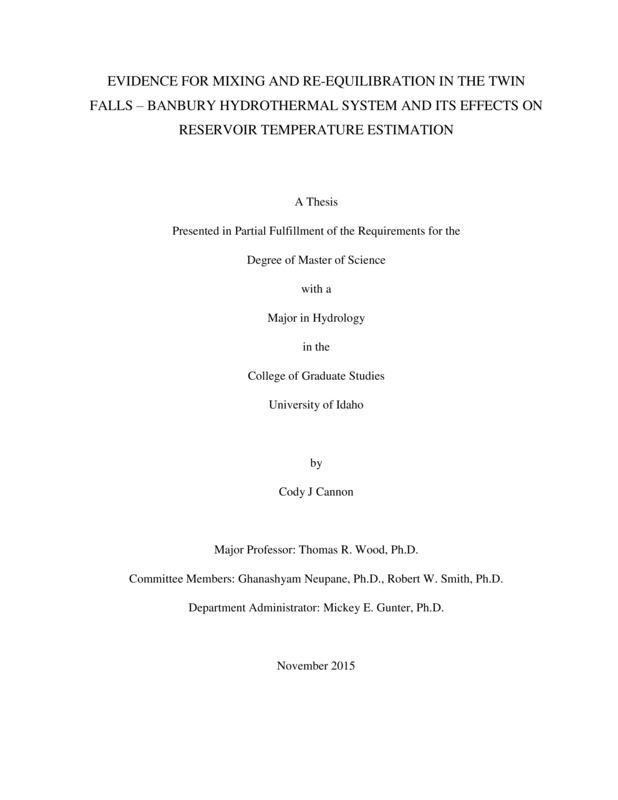Evidence for Mixing and Re-equilibration in the Twin Falls - Banbury Hydrothermal System and Its Effects on Reservoir Temperature Estimation
Cannon, Cody. (2015). Evidence for Mixing and Re-equilibration in the Twin Falls - Banbury Hydrothermal System and Its Effects on Reservoir Temperature Estimation. Theses and Dissertations Collection, University of Idaho Library Digital Collections. https://www.lib.uidaho.edu/digital/etd/items/cannon_idaho_0089n_10778.html
- Title:
- Evidence for Mixing and Re-equilibration in the Twin Falls - Banbury Hydrothermal System and Its Effects on Reservoir Temperature Estimation
- Author:
- Cannon, Cody
- Date:
- 2015
- Keywords:
- Geothermal Multicomponent Equilibrium Geothermometry RTEst Twin Falls - Banbury Hydrothermal Water-Rock Interaction Experiments
- Program:
- Hydrology
- Subject Category:
- Hydrologic sciences; Geochemistry; Geology
- Abstract:
-
The Twin Falls - Banbury area is one of many Known Geothermal Resource Areas located along the periphery of the Eastern Snake River Plain (ESRP). The ESRP is a topographical plain, which was formed by the bimodal volcanism of successive caldera formations associated with the migration of the Yellowstone Hot Spot over the last 16 Ma. Despite temperature gradients of 45-60 oC/km (double the global average) and high heat flow values (110 mW/m2), geothermal utilization within the ESRP is largely limited to direct use with no commercial geothermal development. A gradational trend between deep rhyolite derived Na-K-HCO3 waters of the deep system and basalt hosted Ca-Mg-HCO3 thermal water is observed in deep exploration wells. Mixing between the fluids of the deep system and cooler overlying groundwater as well as re-equilibration of thermal fluids during ascension are considered possibilities that may explain this trend and the low geothermometry temperature estimations of the area. The Twin Falls – Banbury area was chosen as the location for an in depth investigation into the possibility of geothermal mixing and re-equilibration as an explanation for the lower than expected geothermometry.
Evidence for mixing is provided by partial equilibration conditions in most thermal samples as well as a variety of linear mixing trends between both conservative chemical species (Cl, B, δD, etc.) and more reactive species (Ca, Mg, Na, and K). The reactive species show two distinct chemical trends between the two water types that may constitute evidence for different flow paths and/or re-equilibration of thermal fluids at lower temperatures. Multicomponent equilibrium geothermometry (MEG) analysis through the inverse modeling tool RTEst (Palmer, 2013) provides more reliable reservoir temperature estimates for the area through the use of likely reservoir mineral assemblages and the compensation of a mixing component. Results from MEG also support the possibility of re-equilibration. The combination of MEG, high temperature water-rock interaction experiments, and local geological and hydrological data have resulted in a revised conceptual flow model of the Twin Falls – Banbury hydrothermal system.
- Description:
- masters, M.S., Hydrology -- University of Idaho - College of Graduate Studies, 2015
- Major Professor:
- Wood, Thomas R
- Committee:
- Neupane, Ghanashyam; Smith, Robert W
- Defense Date:
- 2015
- Identifier:
- Cannon_idaho_0089N_10778
- Type:
- Text
- Format Original:
- Format:
- application/pdf
- Rights:
- In Copyright - Educational Use Permitted. For more information, please contact University of Idaho Library Special Collections and Archives Department at libspec@uidaho.edu.
- Standardized Rights:
- http://rightsstatements.org/vocab/InC-EDU/1.0/

